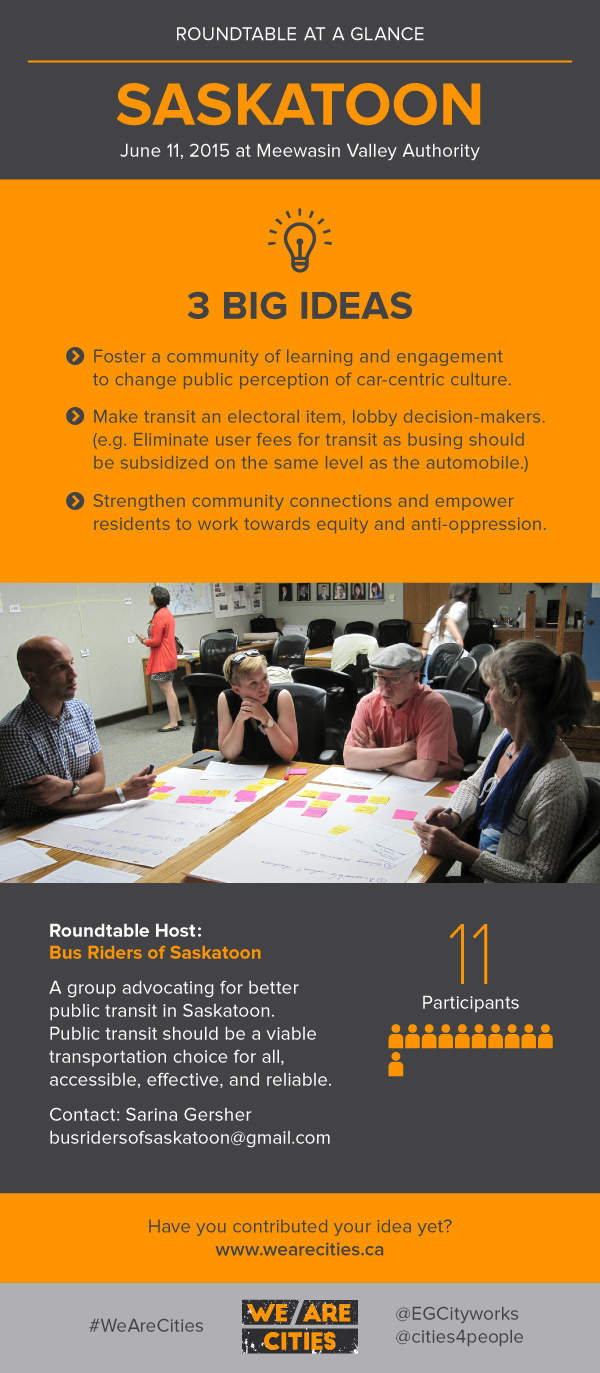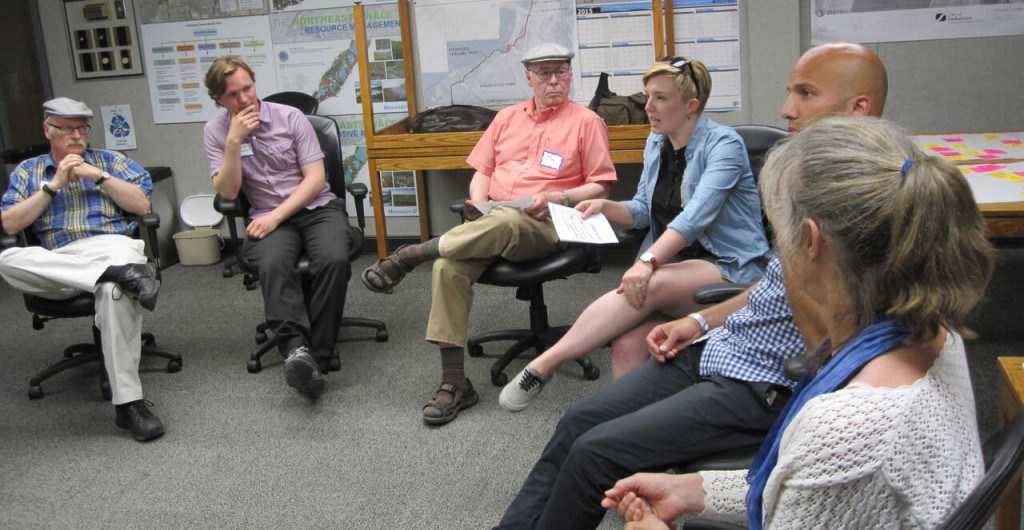What is stopping us from building the kind of Saskatoon we all want to live in? Or, maybe a better question to ask would be, “Is anything stopping us?”
Maybe we just need to get out our shovels.
On Thursday June 11, 2015, a small but mighty group of people gathered at the Meewasin Valley Centre to take part in a roundtable discussion on transit and urban issues. Part of the We Are Cities project, the event was facilitated, skilfully and efficiently, by Sarina Gersher and Mandy Chen of Bus Riders of Saskatoon. Participants came at the questions from many different angles: some worked in public health, some in art and design, others in community organizing and social activism. Some were simply interested as citizens. But what became clear through the evening was that many of us recognize the same challenges in our city, and we also agree on some huge opportunities. The hard part is acting to pursue those possibilities.
Strengths and Challenges: Or, Why You Shouldn’t Ban Swimming
In two groups, participants discussed and presented what we felt were Saskatoon’s three greatest strengths and challenges. Without peeking, both groups produced nearly identical lists of strengths, identifying the river valley, or the accessibility of our natural features, our strong neighbourhood connections, and the vibrancy of culture as our city’s key assets . There was also an overlap in lists of challenges, which included racism, systems of social and economic disparity, resistance to change, car culture, and urban sprawl.
The groups then discussed tools for tackling some of these issues. Some of the phrases which emerged:
- In order to change systems of economic disparity, we must value people and community health over profit.
- In order to decrease division, we must build social bridges.
- In order to overcome systems of socioeconomic disparity, we must engage citizens in working towards equity and anti-oppression.
One of my favourites: people value things more if you give them more access. So in order to protect the river valley, we need to DROP THE BAN ON SWIMMING. WHY SHOULD THE CITY’S FEAR OF LIABILITY DEPRIVE PEOPLE OF THE RIGHT TO GET WET AND SPLASH EACH OTHER?
Okay, I’m calm now.
No Bus is an Island
Later discussion zeroed in on transit issues. It was refreshing for me to hear different voices bringing up ideas that I would have previously have put in the “too hard” and “too expensive” category, and asking “why not?” One participant pointed out that a number of cities have made transit free. (Even Calgary has a ‘free fare zone‘ in the downtown portion of its LRT line.) Since the city doesn’t make back its transit investment through fare revenue anyway, why not increase ridership and get cars off the roads by just making transit free? Sure, there would be challenges. But the point is, don’t dismiss a simple idea, and a good idea, for being too ambitious. Maybe the city should just figure out, “How much would free cost?”
At the end of the evening, we synthesized. Free transit seemed to be one idea that resonated with the group. There was a general feeling that we shouldn’t be afraid to experiment, as a city. We also need to engage with decision-makers and make transit an election issue. And we need to oppose the ongoing expansion of car-centric infrastructure.*
One of my favourite points that was made is that transit has social justice and environmental implications. It has so many connections beyond just itself: really, all urban questions are interwoven and tangled up together. You can’t address one without thinking about all the others.
Transit is an environment issue. Transit is a social justice issue. Transit is a mobility issue. Transit is a community health issue. Transit is a cities issue; transit is a people issue. No bus is an island.
Breaking Out the Shovels
The things we want as part of our city remarkably unified. And if the power structures of “it’s too hard” and “change costs too much” are standing in our way, we need to stop listening to their closed-circuit logic. We need to start doing things.
One of the recent exhibits at the Storefront on 20th Street had a panel on ‘tactical urbanism‘. Basically, that’s the idea of ordinary people doing quick-and-dirty interventions to make their cities and neighbourhoods better. One of the best examples I’ve seen recently went up right across the street from the Storefront. I had the privilege to help a small group of people from Streetforce Youth Centre to build The Scoop, a tiny ice cream shop which gives local First Nations youth a chance at a first summer job. The owner of a parking lot donated the use of his space, a developer donated cladding materials from a house he’s demolishing, volunteers built it, and now these youth who often face discrimination from potential employers get to put something solid on their resume.
That’s tactical urbanism. That’s people doing stuff, getting shovels in the ground.
So I think we need to operate at three levels.**
- One is this very close-grained, small-scale, attack-style action, where we come up with ideas and implement them at a manageable scale, to demonstrate that good stuff can happen.
- Second is to build on that momentum to change the conversation, change public perception, achieve groundswell. Many people hold opinions they inherited, that they didn’t think about, that they don’t “own”. I certainly do. We all need those inherited opinions to be challenged, and we all need to be courageous enough to do that for each other. This is the value of events like 10 Days for Transit, but it is equally the value of friends having conversations and sharing ideas.
- We must not neglect acting at the high levels of authority. Even if power structures frustrate us, even if the city administration often seems to move consistently in the wrong direction, one of the realizations that came out of this discussion is that we often do not take advantage of civic avenues of influence because we do not understand them. This is why I have such respect for certain members of Bus Riders of Saskatoon who sift through City meeting minutes and notices to determine where we should present, how we can argue effectively, where we can insert ourselves to tip the balance of action in favour of transit and good urban planning.
All the different levels of action feed into each other. We can speak to those in the air by showing them what we can do on the ground.
To Sum Up
I think what encouraged those of us who attended this roundtable was the realization that, in more ways than we realized, we are all part of the same Project. We are building one city, and we are that city, and many of us have the same goals. We desire a more equitable, accessible, environmentally thriving, culturally vibrant, socially undivided and interwoven city.
And if we all agree on what kind of city we want to live in, and that kind of city isn’t being built? Then the systems or people in charge are making a mistake, and they need our help.
Let’s get digging.
Notes:
*Another idea was that, while 10 Days for Transit was great, we need a yearlong forum for sharing ‘transit hacks’ and cross-pollinating ideas. Could this website be that place? Could the BRS facebook page be that? Or something else? What can we change to make our sites into more of that thing? Thoughts, anyone?
**Speaking as someone who is very new to activism, and recognizing that wiser people have already thought this through much better than I can.

